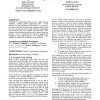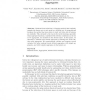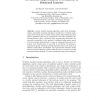1134 search results - page 115 / 227 » Sequential Inductive Learning |
KDD
2005
ACM
15 years 10 months ago
2005
ACM
In this paper, we show that stylistic text features can be exploited to determine an anonymous author's native language with high accuracy. Specifically, we first use automat...
GECCO
2005
Springer
15 years 3 months ago
2005
Springer
Overfitting is a fundamental problem of most machine learning techniques, including genetic programming (GP). Canary functions have been introduced in the literature as a concept ...
ILP
2004
Springer
15 years 3 months ago
2004
Springer
Random forest induction is a bagging method that randomly samples the feature set at each node in a decision tree. In propositional learning, the method has been shown to work well...
ECML
2006
Springer
15 years 1 months ago
2006
Springer
Abstract. Greedy machine learning algorithms suffer from shortsightedness, potentially returning suboptimal models due to limited exploration of the search space. Greedy search mis...
ML
2006
ACM
14 years 10 months ago
2006
ACM
We propose a simple approach to combining first-order logic and probabilistic graphical models in a single representation. A Markov logic network (MLN) is a first-order knowledge b...



